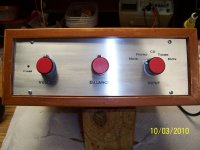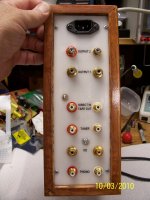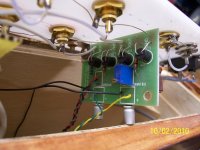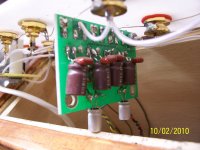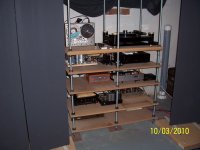Andrew, thats a good start. Use this first. If you feel the urge to tinker then this is the place to do it by adding more capacitance and maybe going to some exotic regulator and current source. Maybe try putting 10uf - 100uf caps on the LED sides of the LDRs.
Maybe a 16V cap on the transformer side of the 7805 isnt such a good idea. You need a higher voltage rating. Dont forget your diodes for DC.
Uriah
Maybe a 16V cap on the transformer side of the 7805 isnt such a good idea. You need a higher voltage rating. Dont forget your diodes for DC.
Uriah
Done. Sort of.
I'm not all that pleased with the cosmetics. I'll use better wood next time, do a better job of staining, and hopefully print lettering better on the faceplate.
But, except for replacing those hideous Radio Shack knobs, at last my LDR attenuator is done.
Thanks, BIG thanks to George for sharing this amazing concept and circuit. George could have kept this to himself and not enabled a competitor or two. His generosity and sharing insight/answering questions have gone above and beyond the call.
Thanks to Uriah for providing us with a source of matched LDRs, easy to use circuit boards and kits.
When I read this, I knew I had to try it out. Unfortunately, I'm cheap, so I used a bit of what I had on hand. Having heard it now, I wish I had used all premium stuff, mainly Cardas Rhodium connectors (I only had two) instead of the assortment of cheapie Cardas and Connex WBT ripoffs.
I have more than one source, so a selector was critical for me. I used SIP reed relays, 5V, with a separate 7805 regulator to keep any transients off the line to the LDRs. The reed relays on FR-4 perf board, interconnect via silver wire from Handmade, with Teflon sleeving as needed. There is a versatile input/output point, sort of like a tape out, connected to the relay output. This serves as either a direct input, bypassing the relays, or an unbuffered output for taping or input to another attenuator (for comparisons). The input selector has "mute" positions where no relay is selected. In one of these positions, the direct input has no more than a couple inches' uninsulated silver wire hanging off of it, which certainly shouldn't affect the sound. This gives the opportunity to use the circuit as George intended, with no selector or contacts in the way.
I used a transformer I had on hand. Schottky diodes, big capacitance, and a common mode choke in the raw supply. Then I configured an LM317 as a current source, followed by a shunt regulator made of a TL431/PNP and a shunt cap of an Elma Silmic. I also used two small 150uF solid polymer electrolytics across the leads from the power supply to Uriah's LDR board. I followed that with a Silmic/film cap combination right across the leads to the LED of each of the LDRs.
The back plate, mounting all of the signal wiring, is Delrin. You can never use enough Delrin. Nice sounding material.
Next time I'll pot the LDR's per George's suggestion.
The sound
So far I've compared it to my old stepped attenuator, Beta Follower line stage and two superb sounding passives, both using TWO P&G 20k stereo pots. One is a DIY preamp, built in Bubinga wood, using Kimber wiring, Shallco selector, etc. The other is from Savant Audio, built in a one-piece solid machined block of Delrin (!!!) and using at least four pieces of Cardas Litz wire per terminal!!! The two stereo pots have their sections paralleled together, making each a mono 10k pot, but with two wipers.
My "Lightspeed" copy sounded far and away better than the DIY
P&G preamp (although it looks so much better). But the Savant was another story. Bass was equal between the two, midrange was full, solid and I think, better in the "Lightspeed". But, the treble was a little better detailed in the Savant preamp. Not much mind you, but a little more "air", you could tell how much pressure the drummer was putting on a brush on a cymbal, for instance.
For me, my passive was a winner, but the owner of the Savant preferred his because of the slightly better resolution. Still, in his words, there are bigger differences in swapping brands of output tubes.
The LDR preamp is a winner. For everyone who's read this and not yet built or bought one:
What in the world are you waiting for?
Stuart
I'm not all that pleased with the cosmetics. I'll use better wood next time, do a better job of staining, and hopefully print lettering better on the faceplate.
But, except for replacing those hideous Radio Shack knobs, at last my LDR attenuator is done.
Thanks, BIG thanks to George for sharing this amazing concept and circuit. George could have kept this to himself and not enabled a competitor or two. His generosity and sharing insight/answering questions have gone above and beyond the call.
Thanks to Uriah for providing us with a source of matched LDRs, easy to use circuit boards and kits.
When I read this, I knew I had to try it out. Unfortunately, I'm cheap, so I used a bit of what I had on hand. Having heard it now, I wish I had used all premium stuff, mainly Cardas Rhodium connectors (I only had two) instead of the assortment of cheapie Cardas and Connex WBT ripoffs.
I have more than one source, so a selector was critical for me. I used SIP reed relays, 5V, with a separate 7805 regulator to keep any transients off the line to the LDRs. The reed relays on FR-4 perf board, interconnect via silver wire from Handmade, with Teflon sleeving as needed. There is a versatile input/output point, sort of like a tape out, connected to the relay output. This serves as either a direct input, bypassing the relays, or an unbuffered output for taping or input to another attenuator (for comparisons). The input selector has "mute" positions where no relay is selected. In one of these positions, the direct input has no more than a couple inches' uninsulated silver wire hanging off of it, which certainly shouldn't affect the sound. This gives the opportunity to use the circuit as George intended, with no selector or contacts in the way.
I used a transformer I had on hand. Schottky diodes, big capacitance, and a common mode choke in the raw supply. Then I configured an LM317 as a current source, followed by a shunt regulator made of a TL431/PNP and a shunt cap of an Elma Silmic. I also used two small 150uF solid polymer electrolytics across the leads from the power supply to Uriah's LDR board. I followed that with a Silmic/film cap combination right across the leads to the LED of each of the LDRs.
The back plate, mounting all of the signal wiring, is Delrin. You can never use enough Delrin. Nice sounding material.
Next time I'll pot the LDR's per George's suggestion.
The sound
So far I've compared it to my old stepped attenuator, Beta Follower line stage and two superb sounding passives, both using TWO P&G 20k stereo pots. One is a DIY preamp, built in Bubinga wood, using Kimber wiring, Shallco selector, etc. The other is from Savant Audio, built in a one-piece solid machined block of Delrin (!!!) and using at least four pieces of Cardas Litz wire per terminal!!! The two stereo pots have their sections paralleled together, making each a mono 10k pot, but with two wipers.
My "Lightspeed" copy sounded far and away better than the DIY
P&G preamp (although it looks so much better). But the Savant was another story. Bass was equal between the two, midrange was full, solid and I think, better in the "Lightspeed". But, the treble was a little better detailed in the Savant preamp. Not much mind you, but a little more "air", you could tell how much pressure the drummer was putting on a brush on a cymbal, for instance.
For me, my passive was a winner, but the owner of the Savant preferred his because of the slightly better resolution. Still, in his words, there are bigger differences in swapping brands of output tubes.
The LDR preamp is a winner. For everyone who's read this and not yet built or bought one:
What in the world are you waiting for?
Stuart
Attachments
Stuart
I think its a fantastic and well thought out build. If you want some nice knobs check the swap meet. Luvdunhill has some knobs for sale. Trust me they will be inexpensive and he is a very nice guy.
Do you get a little delay in volume change with the caps across the power inputs? I did on mine but the caps on the LEDs worked great.
Uriah
I think its a fantastic and well thought out build. If you want some nice knobs check the swap meet. Luvdunhill has some knobs for sale. Trust me they will be inexpensive and he is a very nice guy.
Do you get a little delay in volume change with the caps across the power inputs? I did on mine but the caps on the LEDs worked great.
Uriah
Thanks, Uriah.
I'll post a couple of power supply pictures when the board lets me. I'll check out the swap meet for those knobs.
Very little delay in volume changes or balance changes, sort of like smoothing the motion of the post after you move it. No problem at all.
Stuart
I'll post a couple of power supply pictures when the board lets me. I'll check out the swap meet for those knobs.
Very little delay in volume changes or balance changes, sort of like smoothing the motion of the post after you move it. No problem at all.
Stuart
Stuart,
You may find that different "hitch-up" wires effect the sound, too - the hard-to-find thinner guage silver (4 - 9s) gives better detail, resolution, etc and surprisingly, cleaner, more solid bass!
I understand that the same thing also applies with thinner copper wire too like the Litz, 40# AWG coated, etc
This may seem a bit ridiculous but try different caps on the Leds and see if anything changes - I think it does, but then I've got a pretty active imagination, too!
You may find that different "hitch-up" wires effect the sound, too - the hard-to-find thinner guage silver (4 - 9s) gives better detail, resolution, etc and surprisingly, cleaner, more solid bass!
I understand that the same thing also applies with thinner copper wire too like the Litz, 40# AWG coated, etc
This may seem a bit ridiculous but try different caps on the Leds and see if anything changes - I think it does, but then I've got a pretty active imagination, too!
Hey James,
We're on the same page. What you suggest is completely believable to me. It wouldn't have been a few years back, but I'm convinced now.
Why should putting cones or blocks under a passive line stage make any difference in the sound? I don't know, but it does, and it's not always a given that one solution will work in all similar cases. One setup may sound better with graphite blocks, another may work with Walker Valid Points, another with Clearaudio cones, still another with nothing at all. All we can do is try and listen for differences. Sometimes, nothing at all happens.
One of my favorite chassis wires is the Cardas Litz wire. Real PITA to connect, but worth the trouble.
I thought about using a polypropylene across the LEDs, maybe even a PPFX, but a V-Cap may be a little overkill, eh?
I use an active low pass crossover for my bass panels/amps (-18dB/octave @ ~280Hz), and I need to build a better one. So, I figured to build another LDR line stage (in a full Delrin chassis) incorporating crossover in the same box. I'll try Uriah's Lighter Note and this time use the Cardas wire, better caps, etc.
Hopefully, it will sound even better. But the frustrating side of the hobby is that sometimes an "improvement" doesn't do anything, or moves you backwards!
Stuart
We're on the same page. What you suggest is completely believable to me. It wouldn't have been a few years back, but I'm convinced now.
Why should putting cones or blocks under a passive line stage make any difference in the sound? I don't know, but it does, and it's not always a given that one solution will work in all similar cases. One setup may sound better with graphite blocks, another may work with Walker Valid Points, another with Clearaudio cones, still another with nothing at all. All we can do is try and listen for differences. Sometimes, nothing at all happens.
One of my favorite chassis wires is the Cardas Litz wire. Real PITA to connect, but worth the trouble.
I thought about using a polypropylene across the LEDs, maybe even a PPFX, but a V-Cap may be a little overkill, eh?
I use an active low pass crossover for my bass panels/amps (-18dB/octave @ ~280Hz), and I need to build a better one. So, I figured to build another LDR line stage (in a full Delrin chassis) incorporating crossover in the same box. I'll try Uriah's Lighter Note and this time use the Cardas wire, better caps, etc.
Hopefully, it will sound even better. But the frustrating side of the hobby is that sometimes an "improvement" doesn't do anything, or moves you backwards!
Stuart
Ah, good to hear I'm not the only "nutter" out there!
About the Lightspeed for the lowpass filter - the filters will need to be isolated from the inputs, output and may need some gain so you will need to have buffers or gain stages around the filter section so the basic lioghtspeed arrangement is just fine here - on the output it's different tho and one of Uriah "adjustable Z" versions will be perfect.
There are a couple of rather good electronic Xovers slowly coming together on diyAudio - One is a standard SallenKey Xover that's basically a refined version of the all-purpose to all people multiple everything device trhat was designed a few years ago with the MOX discrete component gain stages.
Aniother is the Stu Yanager type non-feedback valve Xover using those strange things called Gyrators, or synthetic inductors. there is an upgraded (?) version to come soon.
Plenty of other proven designs about to suit.
I haven't tried it yet but those Russian K73-16 petp caps are quite a surprise and these across the Leds would be maybe interesting.
Yeah, that Litz wire is a PIA, but not in the same ballpark as that .04mm Manganin wire to make those U-beaut magic Mobius resistors - THAT is instant frustration!
About the Lightspeed for the lowpass filter - the filters will need to be isolated from the inputs, output and may need some gain so you will need to have buffers or gain stages around the filter section so the basic lioghtspeed arrangement is just fine here - on the output it's different tho and one of Uriah "adjustable Z" versions will be perfect.
There are a couple of rather good electronic Xovers slowly coming together on diyAudio - One is a standard SallenKey Xover that's basically a refined version of the all-purpose to all people multiple everything device trhat was designed a few years ago with the MOX discrete component gain stages.
Aniother is the Stu Yanager type non-feedback valve Xover using those strange things called Gyrators, or synthetic inductors. there is an upgraded (?) version to come soon.
Plenty of other proven designs about to suit.
I haven't tried it yet but those Russian K73-16 petp caps are quite a surprise and these across the Leds would be maybe interesting.
Yeah, that Litz wire is a PIA, but not in the same ballpark as that .04mm Manganin wire to make those U-beaut magic Mobius resistors - THAT is instant frustration!
I got a deal on about 2k ft of 24AWG teflon tube on ebay a few years back. This should last me a lifetime. $17 or something ridiculous like that.
I get cheap silver wire from Myron Toback (google his company) in NY. You can get 99.99% and you can get it soft or hard. I think I paid $22 per ounce which is a lot of 28AWG wire when you are only using a few inches at a time.
I have made several interconnects and use this stuff with the teflon all over my internal wiring.
I have not compared it to much other than copper and silver coated copper in teflon but its the best I have used so far.
There is a guy in Singapore that swears by putting those K73-16 across the LEDs. I bought a bunch of them but need to try it out still. Super inexpensive.
Uriah
I get cheap silver wire from Myron Toback (google his company) in NY. You can get 99.99% and you can get it soft or hard. I think I paid $22 per ounce which is a lot of 28AWG wire when you are only using a few inches at a time.
I have made several interconnects and use this stuff with the teflon all over my internal wiring.
I have not compared it to much other than copper and silver coated copper in teflon but its the best I have used so far.
There is a guy in Singapore that swears by putting those K73-16 across the LEDs. I bought a bunch of them but need to try it out still. Super inexpensive.
Uriah
James,
Nutters of the world unite!
The plan is to have two sets of outputs from the LDRs, as I do now, just paralleled, not buffered or anything. My current XO originated as a Broskie design. I scabbed on a gain stage up front to isolate the network from driving impedance variations and to provide gain when needed (if the bass amp has less gain than the treble amp). I've learned a lot since building it and intend to simply update it with different tubes, CCS loads, servo output, better caps, a better power supply, etc. My old one is in a metal chassis, no more of those ringing nasty sounding cases for me. That's the one with the sandbag on it in my system picture. So the output of the LDRs will feed my tube HF amp, which has a switchable filter between gain stages, and the input gain stage of the low pass filter. The total load will be about 250k, no sweat.
Thanks for the tip on those caps, they look promising. Have you compared them to any "known" caps?
Uriah-
What value caps do they put across the LEDs? Are they using the PETP caps in conjunction with a big electrolytic, or by themselves?
As for testing them, the buffer coming your way is DC coupled with a 1 Meg input impedance, so it's perfect for testing and comparing caps at it's input.
The thing about the Cardas wire, especially the 17.5, is the midrange. I tried using thin, very thin, wiring (Tefzel insulated wire wrap wire) in phono preamps which are very sensitive to such things and it sounded excellent. Switching to the Cardas, no other changes, had the same highs as far as I could tell, but the midrange came alive with very real sounding body. Give some a shot, at $1.45/foot it's not too bad. Makes instruments sound three dimensional and solid.
I wondered about George's original with that sort of attention: machined Delrin box, Cardas wire and Rhodium jacks, etc. But then he'd never sell it for <$500.
Stuart
Nutters of the world unite!
The plan is to have two sets of outputs from the LDRs, as I do now, just paralleled, not buffered or anything. My current XO originated as a Broskie design. I scabbed on a gain stage up front to isolate the network from driving impedance variations and to provide gain when needed (if the bass amp has less gain than the treble amp). I've learned a lot since building it and intend to simply update it with different tubes, CCS loads, servo output, better caps, a better power supply, etc. My old one is in a metal chassis, no more of those ringing nasty sounding cases for me. That's the one with the sandbag on it in my system picture. So the output of the LDRs will feed my tube HF amp, which has a switchable filter between gain stages, and the input gain stage of the low pass filter. The total load will be about 250k, no sweat.
Thanks for the tip on those caps, they look promising. Have you compared them to any "known" caps?
Uriah-
What value caps do they put across the LEDs? Are they using the PETP caps in conjunction with a big electrolytic, or by themselves?
As for testing them, the buffer coming your way is DC coupled with a 1 Meg input impedance, so it's perfect for testing and comparing caps at it's input.
The thing about the Cardas wire, especially the 17.5, is the midrange. I tried using thin, very thin, wiring (Tefzel insulated wire wrap wire) in phono preamps which are very sensitive to such things and it sounded excellent. Switching to the Cardas, no other changes, had the same highs as far as I could tell, but the midrange came alive with very real sounding body. Give some a shot, at $1.45/foot it's not too bad. Makes instruments sound three dimensional and solid.
I wondered about George's original with that sort of attention: machined Delrin box, Cardas wire and Rhodium jacks, etc. But then he'd never sell it for <$500.
Stuart
Stuart,
I think he has 100uf BiPolar Nichicons and a .1uf Russion K73-16 across each.
Uriah
Uriah
You mean bypass with 100uF+0.1uF = 100.1uF or just 0.1uF each leg of the LED...???
How far this improves to the LDR in your opinion?
What actually we try to do here...is it more current to the LED or just to stabilized it???
Gaba and Ray,
I have not yet tried the Russian caps so how much this improves over other .1uf caps I dont know. However I put 100uf and .47uf on each of mine and yes there is an audible difference. Look, the Lightspeed is incredible as is. All these modifications/changes can help but each will be small. The best change is a super quiet power supply. For the low low price of a 10uf up to 100uf cap on each LDR and a little film to bypass that its worth trying and I think you will find a slightly smoother character.
Uriah
I have not yet tried the Russian caps so how much this improves over other .1uf caps I dont know. However I put 100uf and .47uf on each of mine and yes there is an audible difference. Look, the Lightspeed is incredible as is. All these modifications/changes can help but each will be small. The best change is a super quiet power supply. For the low low price of a 10uf up to 100uf cap on each LDR and a little film to bypass that its worth trying and I think you will find a slightly smoother character.
Uriah
Gaba and Ray,
I have not yet tried the Russian caps so how much this improves over other .1uf caps I dont know. However I put 100uf and .47uf on each of mine and yes there is an audible difference. Look, the Lightspeed is incredible as is. All these modifications/changes can help but each will be small. The best change is a super quiet power supply. For the low low price of a 10uf up to 100uf cap on each LDR and a little film to bypass that its worth trying and I think you will find a slightly smoother character.
Uriah
Yes. I agreed LSA is excellent as it is. Tested and proven.
Looks like the cap mod would be a weekend project....
Regarding you suggestion for quiet PSU for the LDR, I'm a bit confuse because I've been using your LDR for a quite a while since I got it from the first batch for matched pairs (100K). As I recall from the earliest pages of the LSA thread you've mention that quiet PSU is not necessary since the signal is 'flowing' along the resistor only but now why needed...?
Gaba,
I didnt know what I was talking about then. I thought I did but I had no idea that there could actually be improvement by changing the supply. I thought we were ONLY lighting an LED, which... yes that is what we are doing but there is more to it than that. If the supply has 'dirty' electricity then the diode (LED) somehow transfers some of that to the resistor. I dont know if they are capacitively coupled because they are so close together or what, but if the supply is a switcher, for example, it might sound wonderful but when you put a better linear supply on it THEN you can tell the difference.
Uriah
I didnt know what I was talking about then. I thought I did but I had no idea that there could actually be improvement by changing the supply. I thought we were ONLY lighting an LED, which... yes that is what we are doing but there is more to it than that. If the supply has 'dirty' electricity then the diode (LED) somehow transfers some of that to the resistor. I dont know if they are capacitively coupled because they are so close together or what, but if the supply is a switcher, for example, it might sound wonderful but when you put a better linear supply on it THEN you can tell the difference.
Uriah
Gaba,
I didnt know what I was talking about then. I thought I did but I had no idea that there could actually be improvement by changing the supply. I thought we were ONLY lighting an LED, which... yes that is what we are doing but there is more to it than that. If the supply has 'dirty' electricity then the diode (LED) somehow transfers some of that to the resistor. I dont know if they are capacitively coupled because they are so close together or what, but if the supply is a switcher, for example, it might sound wonderful but when you put a better linear supply on it THEN you can tell the difference.
Uriah
So bottom line LSA need a good PSU....
Looks like some mojo works when you don't need it sometimes...
Gaba,
I didnt know what I was talking about then. I thought I did but I had no idea that there could actually be improvement by changing the supply.
Love this honesty !!
How very refreshing.
My kit hasn't arrived yet so I'm saving up my questions.
Great to know there are upgrades and tweaks once it's all up and running.
Andrew
I agree with Uriah. I've used an Andrew Weekes Super Reg (ALWSR) with my LSA clone (MkII circuit) and it sounds great. My theory is that a ripply supply will light the LED less perfectly, which is then replicated across the resistive element.
Then again, I usually don't have a clue what I'm talking about WRT electronics!!
Try a decent supply, though. Can't do any harm, can it?
Then again, I usually don't have a clue what I'm talking about WRT electronics!!
Try a decent supply, though. Can't do any harm, can it?
Then again, I usually don't have a clue what I'm talking about WRT electronics!!
Lies! Dont let this guy try to convince you he is ignorant
- Home
- Source & Line
- Analog Line Level
- Lightspeed Attenuator a new passive preamp
